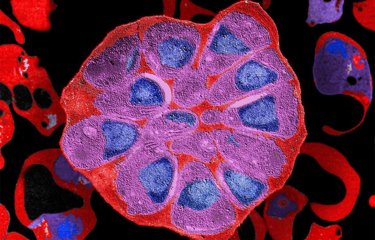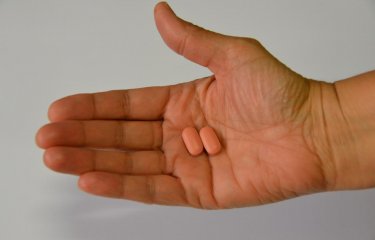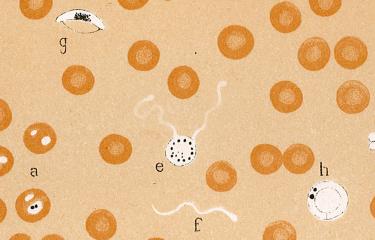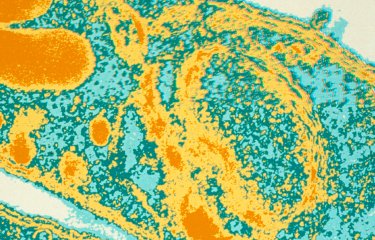Researchers from the Institut Pasteur and the CNRS have brought to light the unique mechanisms that allow the parasite responsible for malaria to fool the immune system of those it infects. In collaboration with researchers from the Walter and Eliza Hall Institute of Medical Research of Melbourne, they showed in two articles published in Cell that the parasite is capable of changing the composition of its immunological "signature" with a high degree of effectiveness. This ability to disguise its presence prevents an infected person's body from producing defences that would allow it to eliminate the infected cells. Understanding these mechanisms should make it possible to more effectively develop tools to fight this scourge, which kills one child every 30 seconds in Africa, and between 1 and 3 million people throughout the world each year.
Press release
Paris, april 14, 2005
In order to fool the immune defences of those infected, the parasite Plasmodium falciparum, which is responsible for malaria, has developed an astonishing power to camouflage itself. When a parasite infects a red blood cell, its presence can be detected by the existence of a parasite protein on the cell’s surface: the immune system can then learn to recognise this protein and develop weapons to eliminate the infected red blood cells.
To counter these defences, the parasites have developed an amazing capacity for disguise by showing themselves capable of quickly changing the immunological signature of this protein, making immune responses ineffective. The mechanisms leading to this immunological variability, which makes fighting malaria so difficult, had remained unknown until this time.
Researchers from the Biology of Host-Parasite Interactions Unit (CNRS-Institut Pasteur, directed by Arthur Scherf) have deciphered the unique mechanism used by the parasite to hide itself in the body. The protein shown on the surface of the red blood cells is produced by a family made up of around sixty genes, called var genes. The researchers showed how the parasites have developed an effective and unique method to select the expression of one or another of these genes at will, by subtly changing the structure itself of the other genes in order to render them inactive. As this phenomenon is reversible, the parasite is able—when the immune defences begin to react—to again modify the choice of the gene expressed, and to make this response ineffective.
The uniqueness of the phenomena deciphered is due to the fact they are epigenetic modifications—in other words, transitory changes in chromatin, the complex structure that supports DNA. These events lead to the neutralisation of the natural genetic regulators in order to influence the phenotype, without altering the parasite’s genetic material. The researchers observed that the DNA takes a specific structure that propagates from the tip of the chromosomes to the nearby site where the var genes are grouped together. This is the first time that such epigenetic regulations have been revealed for the gene regulation of this parasite.
This major discovery opens the way to developing new strategies aiming at countering the protective mechanisms of Plasmodium falciparum and at preventing it from eluding the immune system. This is an essential step for fighting malaria.
Sources
"Telomeric Heterochromatin Propagation and Histone Acetylation Control Mutually Exclusive Expression of Antigenic Variation Genes in Malaria Parasites" Cell, 8 avril 2005.
Lucio H. Freitas-Junior (1), Rosaura Hernandez-Rivas (3), Stuart A. Ralph (1), Dvorak Montiel-Condado (3), Omar K. Ruvalcaba-Salazar (3), Ana Paola Rojas-Meza (3), Liliana Mâncio-Silva (1), Ricardo J. Leal-Silvestre (1), Alisson Marques Gontijo (1), Spencer Shorte (2) and Artur Scherf (1)
1. Unité des Interactions Hôte-Parasite, Institut Pasteur
2. Plate forme d’Imagerie Dynamique
3. Département de Biomédecine Moléculaire, centre de recherche et d’études avancées de l’IPN, Mexico
"Heterochromatin Silencing and Locus Repositioning Linked to Regulation of Virulence Genes in Plasmodium falciparum" Cell, 8 avril 2005.
Manoj T. Duraisingh (1), Till S. Voss (1), Allison J. Marty (1, 2), Michael F. Duffy (3), Robert T. Good (1), Jennifer K. Thompson (1), Lucio H. Freitas-Junior (4), Artur Scherf (4), Brendan S. Crabb (1) et Alan F. Cowman (1)
1. The Walter and Eliza Hall Institute of Medical Research, Melbourne, Australie
2. Departement de Microbiology, Monash University, Clayton, Australie
3. Department of Medicine, University of Melbourne, Melbourne, Australie
4. Unité des Interactions Hôte-Parasite, Institut Pasteur
Contact presse
Institut Pasteur - Press office
Bruno Baron
01 44 38 91 30 - bbaron@pasteur.fr
Nadine Peyrolo
01 45 68 81 47 - npeyrolo@pasteur.fr
CNRS - Press office
Muriel Ilous
01 44 96 43 09 - muriel.ilous@cnrs-dir.fr








